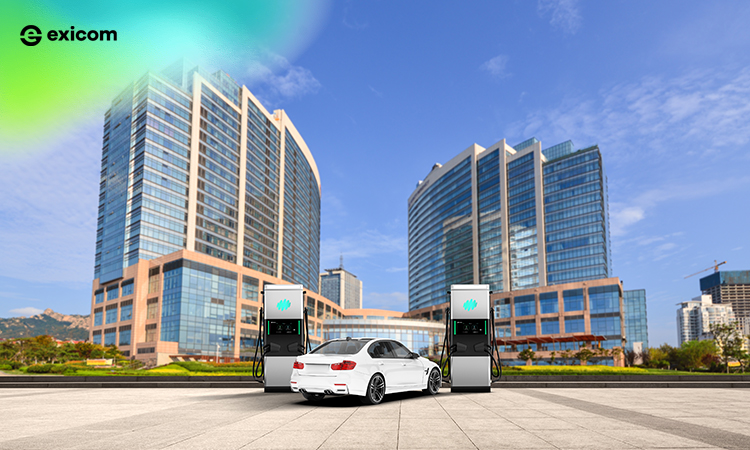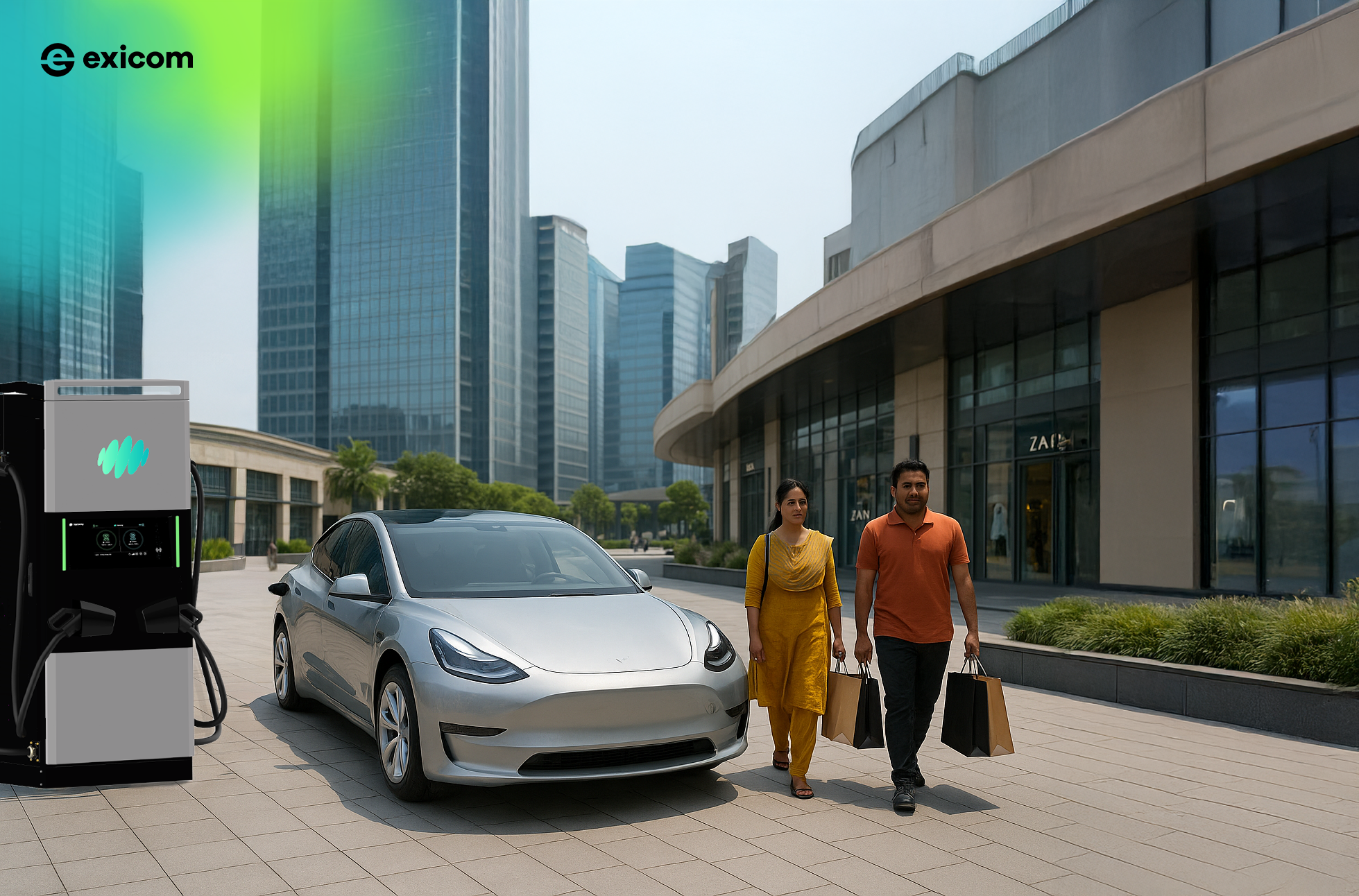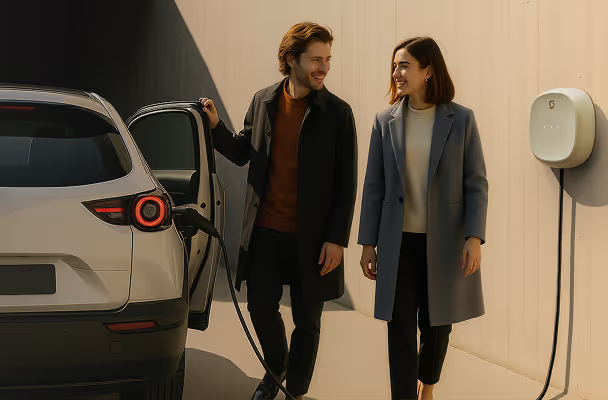How to set up EV Charging Infrastructure in Indian shopping malls

On 7th November 2025, Tesla conducted its first pop-up showcase in India, at DLF Ambience Mall in Gurugram. The launch attracted thousands of visitors to the already bustling venue. That wasn’t why Ravi was there though, but he took notice. Ravi, who has dabbled in commercial real estate and owns a mall himself, witnessed an unprecedented excitement around this electric vehicle (EV) event. Visitors lingered, asked detailed questions, and many even wanted to buy on the spot. On his way back, Ravi took a careful look at the cars on the road. Something he hadn’t done before. A good number of Tata Nexon EVs, MG Windsors EV, and Mahindra XEVs too! He realized that the Tesla showcase is not an isolated occurrence, but a long and stable shift in consumer interest. And that’s when the idea struck him. All these EVs near the mall, they must need EV charging too! Why not have a charging facility in his mall itself? That way, many of these EV owners will visit his mall, and keep coming back.
A lot has changed in EV charging since it’s inception. While the initial perception was primarily around environment friendliness, it is now becoming a convenient and powerful business utility, especially for Indian shopping malls. EV charging infrastructure for shopping malls is being widely adapted since EV users spend more time their and are part of a fast-growing, high-income customer segment.
As more people in India buy electric vehicles, malls that add more EV charging stations will be at advantage. Simply put, the presence of EV charging will soon define how customers and tenants choose properties, much like good parking, strong connectivity, or proximity to a fuel station once did. Early adopters will enjoy higher footfalls, longer dwell times, and stronger tenant relationships. This will help set a new benchmark for modern retail infrastructure.
EV Charging Can Increase Footfalls and Retail Spend
Mall owners already understand that more time spent inside the mall directly increases sales. Interestingly, the average Indian shopper or movie-goer spends about three to four hours on-site, which fits perfectly with a standard EV charging cycle.
A recent EY Mobility Survey (2024) found that over 60% of EV users prefer to charge their vehicles while shopping or dining. This is a clear chance: charging stations can bring in a valuable audience and keep them there longer, which means more users and more spending.
5 Steps to Plan EV Charging Infrastructure in Your Mall
Setting up EV charging in a mall requires careful planning. Here’s a simple step-by-step approach that aligns with real-world conditions and compliance needs.

Step 1: Assess Site Readiness and Footfall Patterns
The right location strategy is the first step to a successful EV deployment. You can't compromise on visibility and ease of use. It’s important to put chargers near the main entrances to the parking, or near anchor stores, where customers will usally walk by and notice. If you want to install EV chargers inside the basement car park, install near the lift, so that everyone who parks is made aware of your mall having this facility.
Keep your cable run distance under 15–25 meters from the electrical panel. Longer distances raise capital costs and make voltage drops harder to manage. Every meter counts in installation efficiency.
Space allocation also matters. Each charging bay should measure roughly 3m x 5m.
And don’t overlook safety and certification.
You’ll need an NOC from the Fire Safety Department. All chargers must meet the safety standards set by the Bureau of Indian Standards (BIS) and the Central Electricity Authority (CEA). Outdoor chargers must have at least IP55 or IP65 protection to guard against dust and rain.
These compliance details keep insurers, auditors, and customers confident that your infrastructure is built to last.
Step 2: Select the Right Charging Mix (AC/DC)
For most malls, a mix of AC to DC chargers delivers the best balance of cost efficiency and customer satisfaction.
Optimise across power ratings, connectors and payments

A good example of this strategy is the R CITY Mall in Mumbai, which shows how commercial deployment can add business value. The mall collaborated with Tata Power to install eight charging stations, including 60 kW DC fast chargers.
The fast chargers allow visitors to top up their vehicles in about 60 to 90 minutes, perfectly matching a shopping or dining visit.
This convenience has positioned R CITY as a destination for EV users and boosted overall traffic. Similar success stories are now seen in Delhi-NCR malls like DLF Mall of India, Select Citywalk, and Ambience Mall, showing a clear nationwide trend.
To make sure that chargers work with all cars, use Type 2 connectors for AC and CCS2 for DC. All chargers must follow OCPP (Open Charge Point Protocol) and OCPI roaming so that people from different networks can easily charge their cars.
Customers will use your EV charging service again if it has a high uptime (ideally 97% or higher) and flexible payment options like UPI, app-based, or RFID access. To ensure high uptime, go for EV chargers with Remote Monitoring Systems (RMS) that do predictive maintenance. Technical issues and risks can be detected by the charger and reported in a central dashboard, which will drastically use your OpEx for regular service and technician visits.
Account for Fleet Compatibility and weather-proofing for outdoor installations
One more point to be noted here, especially for mall owners who are considering installing EV chargers outdoors: Having a few open-access DC chargers can also be very useful for cabs and other public transport that keep frequenting these malls. Drivers often wait outside malls to get rides. If the mall has it’s own EV charging station, they can charge their vehicles in the meantime – creating additional revenue for the mall. The best value for money is chargers that are 60 kW and onwards, because they have higher charging speeds.
Ensure that EV chargers installed in such open areas have a weatherproof design and an IP65 certification for protection against water.
Step 3: Build the Smart Infrastructure
Power Infrastructure Planning and Load Headroom:
- Before you start the installation, check the power load. Set aside an extra 25% load headroom for your mall's EV charging stations so they can handle peak demand. Extra capacity of 60 to 80 kVA may be needed for big malls.
- Regulatory Timelines: In metro cities, distribution companies (DISCOMs) must connect to public charging stations within 7 days. In other places, they have 15 days.
Dynamic Load Management (DLM)
DLM is important for maintaining stable energy levels. It functions by changing the flow of power between the central distribution panel of the mall, chargers and vehicles to stop load surge. This keeps equipment safe, but it also helps keep utility bills from going up.
Wiring and Safety Specifications
Under IS 17017, it’s important for the hardware to be BIS-certified to ensure optimal safety and compatibility. Here’s an understanding of the components and compliance needed for EV charging in malls, usage and compliance.

Step 4: Plan ROI through diverse monetization models
EV charging can be a way to make money and help customers. Malls can either own and run their own chargers or hire a specialised partner to do it for them.
Revenue Models and Pricing Structure

People are opting more for the OpEx, which is the second model. The reason for this is the model’s ability to run a business with more ease. The mall just rents out space and makes money from it without having to worry about upkeep.
Considering how often the parking lot is used and how quickly it fills up, an EV charging setup can easily break even in two to three years, even when EV chargers are owned by the mall.
The branding and returning user potential here is huge too. Partner with a tenant, let’s say: Shopper’s Stop. Imagine an EV owner makes a purchase above INR 3000 in Shoppers Stop’s store of your mall, and gets 30-minutes of EV charging free on their next visit. The EV owner gets the feeling of special treatment, they become a repeat visitor and bring other EV owners in. Shopper’s Stop gets higher revenue and you get a higher commission for running this campaign.
Step 5: Stay Compliant, Stay Ahead
The Bureau of Indian Standards (BIS) requires that all chargers sold in India meet the IS 17017 standards.
Installing EV infrastructure not only meets requirements, but it also helps Green Building Ratings like LEED and IGBC, which improves a mall's worth and ESG profile.
Investors increasingly view these assets as lower-risk and higher-yield properties because of their sustainability readiness.

EV charging is now an essential part of modern retail infrastructure.
Partner with Exicom to design your EV-ready public space: reliable, scalable, and built for the future of mobility.
Frequently Asked Questions
Lorem ipsum dolor sit amet, consectetur adipiscing elit, sed do eiusmod tempor incididunt ut labore et dolore magna aliqua. Ut enim ad minim veniam, quis nostrud exercitation ullamco laboris nisi ut aliquip ex ea commodo consequat. Duis aute irure dolor in reprehenderit in voluptate velit esse.
Lorem ipsum dolor sit amet, consectetur adipiscing elit, sed do eiusmod tempor incididunt ut labore et dolore magna aliqua. Ut enim ad minim veniam, quis nostrud exercitation ullamco laboris nisi ut aliquip ex ea commodo consequat. Duis aute irure dolor in reprehenderit in voluptate velit esse.
Lorem ipsum dolor sit amet, consectetur adipiscing elit, sed do eiusmod tempor incididunt ut labore et dolore magna aliqua. Ut enim ad minim veniam, quis nostrud exercitation ullamco laboris nisi ut aliquip ex ea commodo consequat. Duis aute irure dolor in reprehenderit in voluptate velit esse.
Lorem ipsum dolor sit amet, consectetur adipiscing elit, sed do eiusmod tempor incididunt ut labore et dolore magna aliqua. Ut enim ad minim veniam, quis nostrud exercitation ullamco laboris nisi ut aliquip ex ea commodo consequat. Duis aute irure dolor in reprehenderit in voluptate velit esse.
Lorem ipsum dolor sit amet, consectetur adipiscing elit, sed do eiusmod tempor incididunt ut labore et dolore magna aliqua. Ut enim ad minim veniam, quis nostrud exercitation ullamco laboris nisi ut aliquip ex ea commodo consequat. Duis aute irure dolor in reprehenderit in voluptate velit esse.



